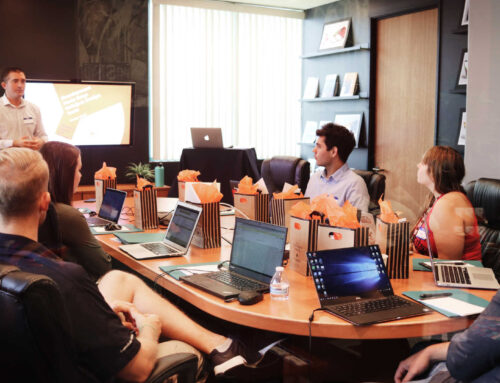In the marketing world, sales copy can make or break your success. Powerful copy can skyrocket conversion rates and get more people engaged with your business.
If you’ve launched a sales page recently, you know how difficult it is to get people excited. With just a few small changes to your sales copy, you might see a dramatic improvement in your conversion rates.
Here are ten secrets of high converting sales pages for you to steal.
Photo via Fotalia.com
1. Your headline has to blow your reader’s mind
The headline is the first thing people see when landing on your website. It’s what convinces your reader to stay on your page, or gives your reader a reason to leave. Your headline is perhaps the most critical element in converting visitors into buyers.
There is no magic formula for a high converting headline. However, there are plenty of headline templates that have been proven to work.
One case study by Soma co-founder, Mike Del Ponte, outlines a 4P approach to headline writing. Using his 4P approach, Mike Del Ponte and his team sold over $100,000 worth of product that hadn’t even been created yet. The four components are simple. When used correctly, you can turn more curious minds into eager buyers just by having a strong headline. Here are the 4P’s to remember when writing your next headline.
- It must make a promise to your reader about a specific benefit.
- It must prove what you’re selling and what you have to offer.
- It must paint a picture of the experience a person has when working with you.
- It must have some element of a strong pitch that convinces people to take action sooner rather than later.
Incorporating these four critical elements requires a lot of thought and careful consideration. When you find a few headline that include each of these topics, test each one to see what gets people excited to learn more about your offering.
2. Make your call to actions more specific
Numerous tests have shown that a couple extra words on your call-to-action button can have a dramatic impact.
People hate to click on a button without knowing exactly what will happen next. Instead of using ambiguous text, such as “Buy Now” or “Sign Up” for your call to action, get more specific. Tell the reader what will happen when he or she clicks.
For example, if your goal is to have your audience sign up for your email list, explain what will happen when he or she hands over an email address. This is difficult with only a few words to play with, but it’s possible. Instead of saying, “Sign Up”, try saying, “Sign Up for Weekly Tips and Tricks” to show the frequency of your emails and what you will send.
3. Use the word “I” in button copy
Another rule of thumb for writing copy for buttons that gets clicked is to write in the first person. The founder of Copy Hacker, Joanna Wiebe, ran a test on her website. The test experimented with a general call to action and a call to action in the first-person.
The first call to action she tested said, “Try Schedulicity Free.” The second call to action said, “End My Scheduling Hassles.”
After conducting A/B tests on the two calls to action, she found that the one using the word “my” received 24% more clicks than the general call to action. Making your call to action more personal solidifies the specific benefit he or she will get when clicking to work with you.
4. Eliminate choice
You’ve probably heard of “analysis paralysis.” This phenomenon is when buyers have too many options to choose from and get paralyzed in the decision making process. When this happens, the buyer often leaves without making a purchase.
Satisfaction rates decline when people have too much to choose from. A study by Iynegar showed that when a person bought a box of chocolates with multiple varieties, their satisfaction decreased. On the contrary, a box of chocolates with only a few choices increased satisfaction rates.
Limit how many options your visitors have to make when buying from you. The more complex the decision making process is, the least likely your customers will buy.
5. Make it easier to say yes
When a new prospect lands on your sales page, the only thing going through his or her mind is, “what’s in it for me?”
Humans are selfish by nature. Before your customer hands over an email address or opens her wallet, she needs to know exactly what benefits she will get by working with you.
Make it as easy as possible for your customer to say yes by outlining these benefits. Instead of simply showing WHAT your customer gets when she purchases, show WHAT HAPPENS to her after she makes a purchase. For example, if you sell knitting supplies, outline how your knitting supplies will make your buyer’s life a little bit better. That might mean faster knitting times, easier completion of projects, more versatility when knitting and more.
Giving your sales page visitor the core benefits of buying from you makes the decision process easier. It enables your visitor to visualize the experience she will have with your product after she buys.
6. Don’t get too fancy
Sometimes marketers get excited. It’s normal, but it can make sales copy a little bit confusing when the excitement goes overboard.
Don’t get too fancy with your sales copy that you fail to clarify what you offer. Eliminate fluff in your text that could cause confusion and kill conversion rates. Take out any jargon or marketing-speak that could sound overly complex.
To boost conversions, focus on conveying value in the simplest format possible.
7. Don’t overhype your offering
For a customer to buy from you, there has to be a healthy level of trust.
Too much hype kills that trust level. Your customers are left to wonder if you’re sales message matches the actual benefit he or she will receive when buying from you. If your product is good enough to sell, then it has enough value on its own to drive conversions without the sleazy, cringe-worthy hype.
8. Benefits outweigh solutions every time
People land on your sales page looking for a solution to a problem. But what they want isn’t a solution – they’re looking for a direct benefit to improve their life and solve a struggle.
Give your visitor a reason to buy with benefit statements. Don’t offer specific specs of your product. Those could confuse your reader. Worse yet, they might not be able to see how each solution or spec meets a need.
Show the direct benefits to each part of your product as a way to show why a person should buy from you. For example, if you sell grills talk about how fast your grill heats up, how consistently it cooks, and how easy it is to clean. Each of these outlines the benefits of your product, while also addressing the solutions your product solves.
9. Make your sales copy easy to scan
People are busy. They aren’t looking for a sales pitch when they land on your website, they’re looking for a reason to work with you.
You only have a few seconds to capture your visitor’s attention before she makes a snap judgment about what you have to offer. If your sales copy is easy to scan, you’ll be more likely to get across what you need to convey in a shorter period of time. Use bullet points, images, and other tools to make your copy easy to scan over quickly.
10. Test, test, test
There is no “one-size-fits-all” solution to driving conversions. Your audience is as unique as your product. To reach the core group of people you serve, you need to tailor your marketing and sales page to their interests, needs, and passions.
Test your message to find out what resonates and what falls flat. When testing, make small tweaks to your copy so you get a realistic view of what drives better conversions. Over time you will start to see certain patterns making your sales copy more impactful.
What is the best way you’ve found to drive conversions on your website?






